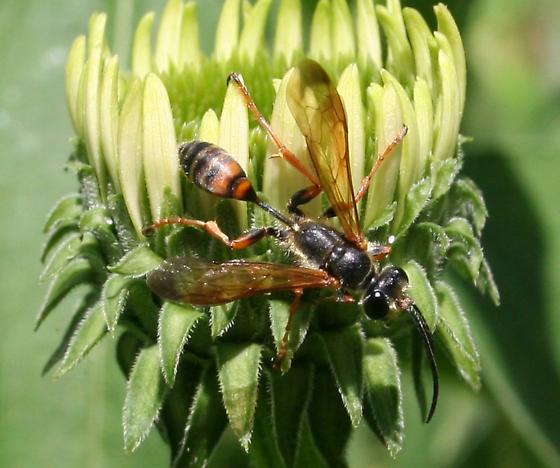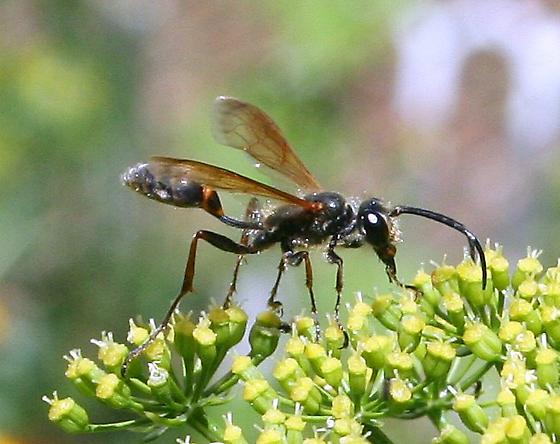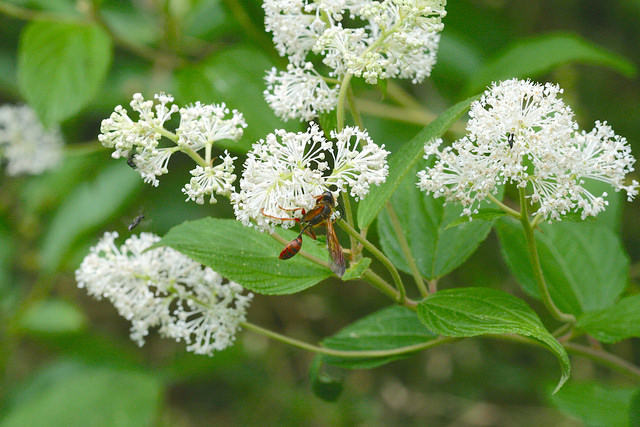Map Snapshot


2 Records
Status
Formerly a Western species, it has been found in the Northeast in the past several years (BugGuide). "At least part of the genus needs revision. It is possible that elegans (subgenus murrayella) may eventually become a synonym of I. mexicana, or vice versa" (Eric R. Eaton, BugGuide).
Seasonality Snapshot
Source: Wikipedia
| Isodontia elegans | |
|---|---|

| |
| Scientific classification | |
| Domain: | Eukaryota |
| Kingdom: | Animalia |
| Phylum: | Arthropoda |
| Class: | Insecta |
| Order: | Hymenoptera |
| Family: | Sphecidae |
| Tribe: | Sphecini |
| Genus: | Isodontia |
| Species: | I. elegans
|
| Binomial name | |
| Isodontia elegans | |
| Synonyms[1] | |
| |
Isodontia elegans, also known as the elegant grass-carrying wasp, is a species of solitary, nest-provisioning,[2] thread-waisted wasp in the family Sphecidae that hunts orthopterans (grasshoppers, crickets, bush crickets, locusts, etc.).[1][3][4][5]
I. elegans is described as having a generally black-color body, rusty-red to yellowish abdomen, and see-through wings with some tinting.[6] They were originally considered to be a species of western and southern North America,[6] but have been found in the northeastern corner of the continent in increasing numbers.[5] They seem to use pre-existing holes created by other insects for their nests and then outfit them with "finely chewed fibers of dead weeds and grass."[6] The grass serves as a defensive barrier at one end of the nest; it keeps parasites from entering while the larvae feed on the paralyzed insects which have been stored in the nursery.[7]
Isodontia elegans may be attracted to same kind of nest holes that appeal to blue orchard mason bees.[2]
References
[edit]- ^ a b "Isodontia elegans Report". Integrated Taxonomic Information System. Retrieved 2018-04-22.
- ^ a b Spendal, O'Neill & Delphia (2021), p. 559.
- ^ "Isodontia elegans species details". Catalogue of Life. Retrieved 2018-04-22.
- ^ "Isodontia elegans". GBIF. Retrieved 2018-04-22.
- ^ a b "Isodontia elegans Species Information". BugGuide.net. Retrieved 2018-04-22.
- ^ a b c Fernald, Henry Torsey (1906). The Digger Wasps of North America and the West Indies Belonging to the Subfamily Chlorioninae. United States National Museum. pp. 361–364.
- ^ Ainslie, C. N. (November 1924). "Note on the Nesting Habits of Chlorion Elegans". The Canadian Entomologist. 56 (11): 269–270. doi:10.4039/Ent56269-11. ISSN 0008-347X.
- Spendal, Ronald C.; O'Neill, Kevin M.; Delphia, Casey M. (2021-12-15). "Nesting Biology and Offspring Development of the Cavity-Nesting Solitary Wasp Isodontia elegans (F. Smith) from Trap-Nests in Oregon". Western North American Naturalist. 81 (4). doi:10.3398/064.081.0408. ISSN 1527-0904. ProQuest 2619125096.
External links
[edit] Media related to Isodontia elegans at Wikimedia Commons
Media related to Isodontia elegans at Wikimedia Commons


